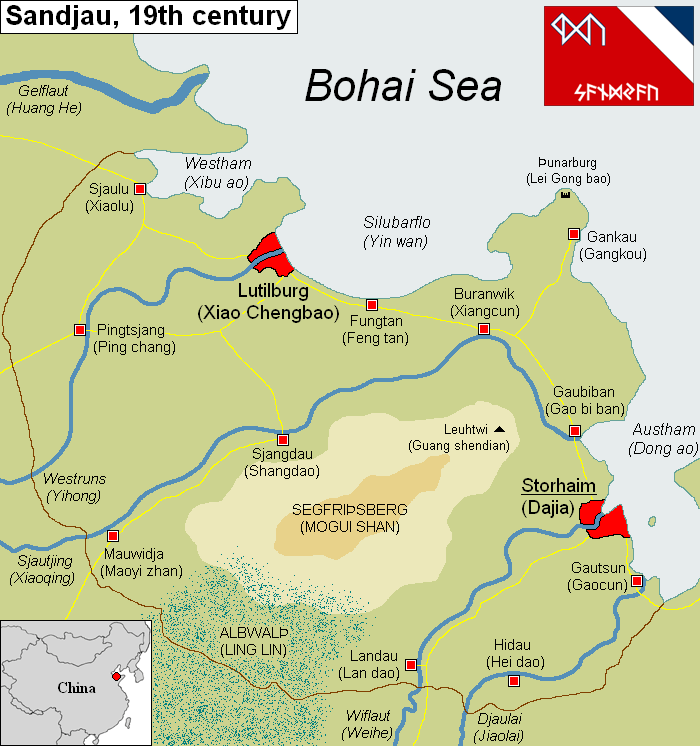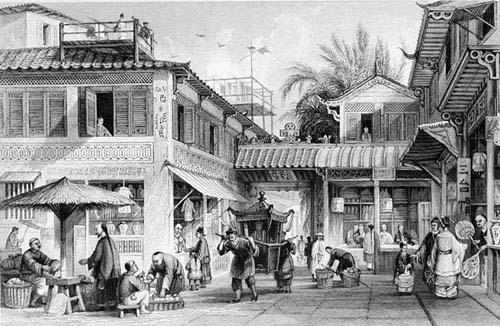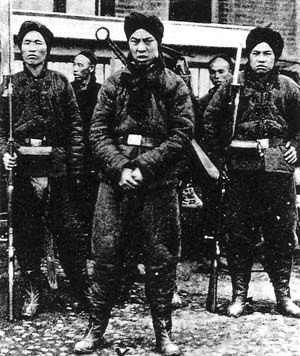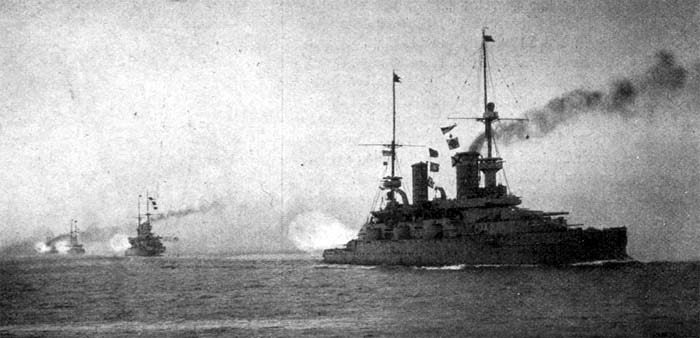  SandjauGeneral information From the 17th to the 20th century Sandjau was a trading post of the Frilandic companies DWU and (later) FMD. These days, the area is the Sanjiaozhou prefecture of the Chinese province of Shandong. It's about the size of Luxemburg and lies at the Bohai Sea, west of Laizhou. Modern Sanjiaozhou has 6 million inhabitants but around 1900 Sanjau was inhabited by about 400,000 people: 398,000 Han Chinese and 2000 Westerners, of which 800 Frilanders, 400 British, 350 Germans, 300 Americans, 100 French and 50 other. The official language was Frilandic, but in reality hardly anything but Mandarin Chinese was spoken.  History The founding of Sandjau In 1685 emperor Kangxi decided to lift the limitations on trade, allowing European states to freely trade with China. The Frilandic company DWU then asked permission to found a trading post at the Chinese coast and was given the seaport Dajia and the surrounding area as a loan. This land formally remained part of China, but the DWU was allowed to govern the area and had to pay an annual rent for this. In 1690 the DWU managed to also have the city of Xiao Chengbao added to this area. They paid well for this and the fact that the Frilanders were no Christians and didn't want to convert anyone, also worked to their advantage. The area between both cities soon fell within the DWU's sphere of influence. Dajia and Xiao Chengbao were renamed to Storhaim and Lutilburg and the area as a whole was named "Sandjau", which was derived from the original Chinese name for the area: Sanjiaozhou ("River delta"). The names of many towns, rivers and other places were also literally translated or spelled like how they sounded to Frilandic ears. The flag of Sandjau became the dark red DWU flag with company logo, with in the upper right the Frilandic blue and white and below the name "Sandjau" in runic writing. Opium trade In Sandjau the DWU mainly bought tea and Chinese porcelain, which was very popular in Europe at the time. However, the Chinese showed little interest in Frilandic products, which is why the DWU didn't make the high profits it had expected. But a solution was found for this: free test samples of opium were distributed amongst the Chinese population. Many people became addicted to it and the demand for opium rose. The DWU imported this in large quantities and Sandjau became one of Asia's biggest opium hubs. Big profits were made with this, but at the expense of the Chinese people. The humble trading post of Sandjau had developed into a powerful corporate colony, where not the Chinese emperor, but the DWU was in charge. In the late 17th century the sale of opium decreased due to heavy competition from Dutch and British dealers. On other markets the DWU also suffered heavy losses and the company was desperately looking for ways to start making profit again. On a meeting in 1796 Gremhar Ansgarssun, DWU governor of Sandjau, even mentioned that his territory possessed "large supplies of Chinese" and that these could "perhaps be sold for a good price." As a result of this plan, a few thousand Chinese were sold to slave traders. In 1799 emperor Jiaqing put an end to these practices by threatening to expel the DWU from Sandjau and denying the company access to the Chinese market. The DWU, which was financially weakened, preferred to stay on the emperor's good side and bowed to his demands.
Bankruptcy and take-over In 1800 the DWU went bankrupt. Because the Frilandic state was not prepared to take over the bankrupt and tainted DWU heritage, governor Stainberht Raudassun was planning to transfer Sandjau back to China. This was very much against the wishes of Langa Tiswaldssun, a rich businessman who had big financial interests in Sandjau. He therefore founded the FMD ("Frilandisk-Murganlandiska Dreugshans" or Frilandic-Asiatic Trading Company) and managed to convince the Chinese emperor to allow his company to take over all rights and obligations of the DWU in China. Sandjau therefore continued to exist and was from then on governed by a new company, which, by the way, was not a whit better than the DWU and exploited the people even worse than before. The FMD tried to convince Friland to formally adopt Sandjau as its colony, but the Riksžing wasn't very willing. It did declare Sandjau to be a Frilandic protectorate, granting it a certain degree of military and diplomatic protection. On paper, the FMD administration maintained the old DWU flag, but in practice it replaced this with the Frilandic blue-white, even though it didn't have permission for this and the area didn't officially belong to the kingdom of Friland. FMD colony In 1850 the FMD administration stopped paying rent to China and unilaterally declared the area independent. The Chinese emperor was furious, but the FMD got away with it because of the weakened position of the Qing dynasty, the widespread corruption in the country and the fact that Portugal and Great Britain had practically done the same thing with Macau and Hong Kong. To protect the territory, the FMD formed a garrison: the Feraustanskul (Far East Squad). Because it was feared that Chinese soldiers would side with the natives during an uproar, mainly Indians and Europeans were recruited and all officers were Frilanders. In 1856 the Feraustanskul was deployed for the first time: all land between the Westham, Austham and the Albwalž, most of which only belonged to the FMD's sphere of influence, was occupied and violently brought under FMD rule. Later that year China and Sandjau signed the Treaty of Storhaim, in which China acknowledged Sandjau's sovereignty and renounced its claims on the annexed territory. Of course China didn't do this voluntarily, but because internal turmoil had brought the country on the brink of collapse, it had little choice. Furthermore, doing this also prevented more annexations. Naval base Because of the increasing tensions with the British Empire (England crisis) and Hiveria (Fourth Frilandic-Hiverian War), Friland needed a naval base in Asia to better protect its interests in the region. The Frilandic protectorate of Sandjau was a logical choice and the area became an important base of operations for the Stellasaiflot ("Pacific Fleet") of the Frilandic Navy. In exchange for its continued protection and an annual financial contribution, the kingdom of Friland was allowed to use the port of Storhaim, which was deep enough for large navy vessels. At the end of the 19th century it was a coming and going of heavy warships in the port of Storhaim. The harbour kept expanding and to protect Sandjau against enemy ships, the FMD built a large bunker complex with enormous cannons at the coast, north of Gankau: Žunarburg. An additional advantage of the naval base was that the many sailors stimulated the local economy. Also, Friland now needed Sandjau and could therefore not afford much criticism of the FMD's human rights violations.
The Boxer Rebellion In 1899 unrest broke out in China. Yihetuan rebels, also known as "Boxers", started to resist against the Western influences in their country. In Sandjau many people joined them and everywhere there were attacks on Westerners and on the Chinese that cooperated with them. The FMD deployed the Feraustanskul to restore order, but it couldn't prevent that the outskirts of Sandjau, especially the area southwest of the line Sjaulu-Hidau, was fully taken over by the rebels. In Pingtsjang the Boxers caused a massacre, in which thirty Westerners were beheaded, including the women and children. The year thereafter, they attacked the cities of Storhaim and Lutilburg. Storhaim managed to fight off the attacks with the help of Frilandic sailors, but large parts of Lutilburg were occupied. Street fights broke out and the Feraustanskul managed to hold the city center and the harbour, allowing ships from Storhaim to keep supplying them with food, weapons and ammunition. Frilandic aid Because Sandjau was its protectorate, Friland sent troops to relieve the area. These arrived in the port of Storhaim on June 25, 1900 and recaptured the area southeast of the Segfrižsberg in the days thereafter. At the same time Frilandic armoured cruisers in the Silver Bay (Silubarflo) bombarded the occupied parts of Lutilburg, reducing entire districts to rubble. On July 7 the city was liberated by Rikshar troops. In the weeks thereafter, the Frilandic army cleared all of Sandjau from rebels, in which many civilians were also killed. Not only as a revenge for the massacre of Pingtsjang, but also because of a dubious order from general Warg Isarnfrižssun, which said: "Every Chinese that gives you a rebellious look... Shoot him!" In August 1900 other Western countries, together with Russia and Japan, ended the Boxer Rebellion.
End of protectorate After the Boxer Rebellion the mutual distrust had risen to such a level, that the FMD administration started treating the population even worse and punished even the slightest disobedience with extreme measures. In 1932 governor Hilda Alfrižsduhter even ordered the arrest of one tenth of the population of Sjangdau, after which the men were deployed as forced labourers to build roads and bridges and the women were put to work as prostitutes in the port of Storhaim. Meanwhile, fierce debates were raging in Frilandic parliament about the crimes committed by the FMD and the behaviour of the Frilandic army during the Boxer Rebellion, which had, according to parliament, damaged the kingdom's reputation. Therefore, it was decided in 1934 to retreat the Pacific Fleet and no longer act as protector of the FMD colony. Japanese invasion Friland's departure was disastrous for Sandjau and seriously weakened its military and political position. The Japanese Empire, which dominated northeastern China, seized the opportunity and prepared for an invasion. Many Westerners fled the area and Friland sent ships to repatriate its citizens if desired. Three quarters of them made use of this. The majority of this group moved to Frilandic Tagaloa, where they founded the village of Neu-Sandjau. In May 1935 Japanese troops invaded Sandjau from multiple directions. The administration couldn't count on the Chinese population, because it had an equal aversion towards both Japan and the FMD. The Feraustanskul, which was hopelessly outnumbered, therefore decided to relinquish all of western Sandjau with Lutilburg included, and retreat to Storhaim and Gankau. The only success it had, was the sinking of the Japanese cruisers Fushidara and Keishou, that had gotten to close to the cannons of the Žunarburg.
The end of Sandjau On May 24 the troops of the Feraustanskul on the Gankau peninsula were defeated and the Žunarburg fell to the Japanese. Thereafter Storhaim was surrounded, bombed flat and every ship that tried to flee, was sunk by Japanese submarines. FMD governor Hilda Alfrižsduhter realised the hopelessness of the situation and tried to contact Japan about a conditional surrender. However, her messages were ignored and on May 27, 1935 Storhaim was occupied by the Japanese army and the colony of Sandjau ceased to exist. The part of the Frilandic population that hadn't fled yet, mainly FMD personnel and their families, were put in camps. Ironically enough in the same camps in which the FMD had locked up its Chinese prisoners. Later, the men were used as forced labourers to repair the infrastructure and the women were sent to Japanese army brothels, including the governor... Present Sanjiaozhou After World War 2 Sandjau was returned to China and regained its old name of Sanjiaozhou. Some remnants of the colonial period are the Guang shendian temple (Leuhtwi), Lei Gong bao (Žunarburg), the railway station, governors house and port building of Dajia (Storhaim), the Frilandic cemetery of Xiao Chengbao (Lutilburg) and the barracks of Lan dao (Landau).  Settlements:
Settlements:Storhaim (Chinese: Dajia / "Great home") The former capital of Sandjau, mainly known for its big port and a number of beautifully preserved examples of Frilandic architecture. Lutilburg (Chinese: Xiao Chengbao / "Little Castle") In size the second city of Sandjau/Sanjiaozhou, named after the small castle of warlord Wang Wei, which still exists. Gautsun (Chinese: Gaocun / "High village") A fishing village since times of old, but due to water pollution the fishing sector has seriously diminished. Landau (Chinese: Lan dao / "Blue island") Built on an island in the Wiflaut/Weihe, which has clear, blue water. Hidau (Chinese: Hei dao / "Black island") Built on an island in the Djaulai/Jiaolai, which has darker water than the Wiflaut/Weihe. Pingtsjang (Chinese: Ping chang / "Flat field") Lies on an open plain, in which the river Westruns/Yihong is the only point of reference. Sjangdau (Chinese: Shangdao / "High road") A calm village at the foot of the Segfrižsberg/Mogui shan. Buranwik (Chinese: Xiangcun / "Farmer village") Named like this because of the many fields and pastures in this area. Gankau (Chinese: Gangkou / "Harbour") In the 19th century this fishing village was an important residence of Frilandic navy personnel. Fungtan (Chinese: Feng tan / "Windy beach") The best seaside resort in Sandjau/Sanjiaozhou, except for the heavy wind and the not so clean water. Gaubiban (Chinese: Gao bi ban / "High wall") Many Westerners from Storhaim used to have a cottage here, these days it's mainly inhabited by rich Chinese. Sjaulu (Chinese: Xiaolu / "Market") Since days of old known for its fish and vegetable market. Mauwidja (Chinese: Maoyi zhan / "Trading post") Much of the trade between the western part of former Sandjau and the rest of China, went through this remote trading post. Other locations: Žunarburg (Chinese: Lei Gong bao / "Stronghold of the Thundergod") Large bunker complex with heavy cannons, built in 1882 as a defence against hostile ships. During the Japanese invasion of 1935 there's been heavy fighting here, in which the Japanese cruisers Fushidara and Keishou were sunk. The wreckages can still be found near the coast. These days the Žunarburg is mainly the domain of the homeless and graffiti artists. Leuhtwi (Chinese: Guang shendian / "Temple of Light") Big temple, in which Ferna Sed, Christianity, Islam, Buddhism, Taoism and all other religions of Sandjau could be professed. Built in 1798 by Stainberht Raudassun, the most moderate and also last DWU governor before the FMD take-over in 1800. Nowadays the Temple of Light is mainly a tourist attraction. Albwalž ("Elfwood", Chinese: Ling Lin / "Wood of the Spirits") According to the legends this wood is inhabited by spirits of nature, who bring luck to those who bring them offerings. Segfrižsberg ("Siegfried's Mountain", Chinese: Mogui shan / "Devil's Mountain") 600 meters (1968 feet) high and named after the mythological hero Siegfried. However, the Chinese mainly associated this name with governor Segfriž Alwenssun (middle 18th century), who imprisoned many innocent people. For that reason they called it Devil's Mountain. Raginwaldsai ("Raginwald Sea", Chinese: Bo Hai / "Bohai Sea") Frilandic colonists named the Bohai Sea after king Raginwald (1659 - 1692). Silubarflo (Chinese: Yin wan / "Silver Bay") (inlet) Westham (Chinese: Xibu ao / "Western inlet") (inlet) Austham (Chinese: Dong ao / "Eastern inlet") (inlet) Gelflaut (Chinese: Huang He / "Yellow River") (river) Westruns ("Western river", Chinese: Yihong) (river) Sjautjing (Chinese: Xiaoqing) (river) Wiflaut ("Hallowed river", Chinese: Weihe) (river) Djaulai (Chinese: Jiaolai) (river)  |



